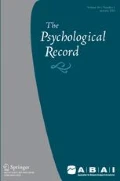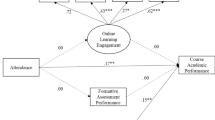Abstract
One intervention used to increase attendance at collegiate class meetings is to provide points for activities that take place in class; however, the percentage of course points necessary to facilitate high attendance is unknown. In Experiment 1, we assessed the relation between the relative percentage of points available for in-class activities and student attendance across three psychology courses. Across all three courses, students were more likely to attend on class days when higher percentages of course points were available for in-class activities. In Experiment 2, we replicated our findings from Experiment 1 while assessing the relation between the absolute value of points available and student attendance across two additional psychology courses. The results of Experiment 2 show that the absolute number of points available influenced attendance less than the relative value of course points available for in-class activities. Our findings suggest that instructors should consider the relative value of points available on class days when attempting to design course activities to maximize attendance.



Similar content being viewed by others
References
Beaulieu, R. P. (1984). The effects of traditional and alternate rewards on attendance. College Student Journal, 18, 126–130.
Bicard, D. F., Lott, V., Mills, J., Bicard, S., & Baylot-Casey, L. (2012). Effects of text messaged self-monitoring on class attendance and punctuality of at-risk college student athletes. Journal of Applied Behavior Analysis, 45, 205–210. doi:10.1901/jaba.2012.45-205.
Butler, A., Phillmann, K., & Smart, L. (2001). Active learning within a lecture: Assessing the impact of short, in-class writing exercises. Teaching of Psychology, 28(4), 257–259. doi:10.1207/S15328023TOP2804_04.
Credé, M., Roch, S. G., & Kieszczynka, U. M. (2010). Class attendance in college: A meta-analytic review of the relationship of class attendance with grades and student characteristics. Review of Educational Research, 80, 272–295. doi:10.3102/0034654310362998.
Hautau, B., Turner, H. C., Carroll, E., Jaspers, K., Parker, M., Krohn, K., & Williams, R. L. (2006). Differential daily writing contingencies and performance on major multiple-choice exams. Journal of Behavioral Education, 15, 259–276. doi:10.1007/s10864-006-9031-9.
Hovell, M. F., Williams, R. L., & Semb, G. (1979). Analysis of undergraduates' attendance at class meetings with and without grade-related contingencies: A contrast effect. The Journal of Educational Research, 73, 50–53.
Laraway, S., Snycerski, S., Michael, J., & Poling, A. (2003). Motivating operations and terms to describe them: Some further refinements. Journal of Applied Behavior Analysis, 36, 407–414. doi:10.1901/jaba.2003.36-407.
Messling, P. A., III, & Dermer, M. L. (2010). Increasing students’ attendance at lecture and preparation for lecture by allowing students to use their notes during tests. The Behavior Analyst Today, 10, 381–390.
Michael, J. (1991). A behavioral perspective on college teaching. Behavior Analyst, 14, 229–239.
Pennebaker, J. W., Gosling, S. D., & Ferrell, J. D. (2013). Daily online testing in large classes: Boosting performance while reducing achievement gaps. PLoS ONE, 8(11), e79774. doi:10.1371/journal.pone.0079774.
Rehfeldt, R. A., Walker, B., Garcia, Y., Lovett, S., & Filipiak, S. (2010). A point contingency for homework submission in the graduate school classroom. Journal of Applied Behavior Analysis, 43, 499–502. doi:10.1901/jaba.2010.43-499.
Ryan, C., & Hemmes, N. (2005). Effects of the contingency for homework submission on homework submission and quiz performance in a college course. Journal of Applied Behavior Analysis, 38, 79–88. doi:10.1901/jaba.2005.123-03.
von Mizener, B. H., & Williams, R. L. (2009). The effects of student choices on academic performance. Journal of Positive Behavior Interventions, 11(2), 110–128. doi:10.1177/1098300708323372.
Wilder, D. A., Flood, W. A., & Stromsnes, W. (2001). The use of random extra credit quizzes to increase student attendance. Journal of Instructional Psychology, 28, 117–120.
Author Note
We would like to thank Ashley Crane, Brooke Iames, and Kristen Wandling for assisting with data collection.
Author information
Authors and Affiliations
Corresponding author
Ethics declarations
The authors declare that they have no conflicts of interest. All procedures performed in studies involving human participants were in accordance with the ethical standards of the institutional and/or national research committee and with the 1964 Helsinki declaration and its later amendments or comparable ethical standards. For this type of study, formal consent was not required.
Rights and permissions
About this article
Cite this article
Carroll, R.A., St. Peter, C.C. Proportion of Available Points Predicts Student Attendance in College Courses. Psychol Rec 67, 61–69 (2017). https://doi.org/10.1007/s40732-016-0207-y
Published:
Issue Date:
DOI: https://doi.org/10.1007/s40732-016-0207-y




